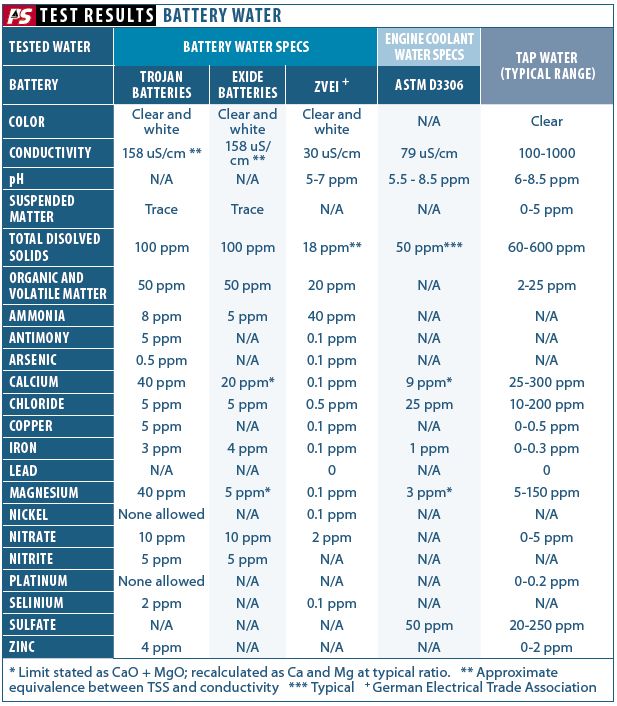Our May 2015 report on absorbed glass mat (AGM) batteries got us thinking about wet cell-batteries. While it is easy to find distilled water suitable for topping off the battery electrolyte in the U.S., what happens when we are not near a reliable supply? Are there any substitutes? What should we avoid?
We compared what the manufacturers recommend for new batteries coming out of the factory with what they recommend for topping off. We also looked up standards for water used to blend engine coolants. (See table.) It turns out that engine coolant specifications are just as stringent as those for topping off a battery.
In our quest to identify safe and unsafe sources of water for our battery and engine, we were most interested in the total dissolved solids (TDS) of the water. Total dissolved solids is calculated from conductivity and is a measure of dissolved ions in the water, including calcium, chloride, sulfate, and carbonate. Although battery manufacturers allow up to 100 parts per million (ppm) TDS for topping off, manufacturing standards are much lower (10 to 18 ppm). We suggest following the latter guideline.
For our test, we also recorded pH levels to determine acidity. We used a TDS meter and simple pH strips to compare samples; both of these are handy, relatively inexpensive tools that are worth having for long-term cruising. (See PS July 2015 online.)
We tested more than a dozen water samples, including multiple distilled-water samples from neighborhood stores, rainwater, onboard and home air-conditioning condensate, dehumidifier condensate, home and onboard reverse osmosis (RO) water systems, plain tap water (home and marina), and bottled drinking water.
All of the distilled water and rainwater samples we tested were less than 10 ppm TDS. Our rainwater samples were taken in a well-protected seawater harbor; if there was more spray, the result would be different.
Reverse-osmosis water from a residential tap was 17 ppm, and dehumidifier water was less than 30 ppm, suitable in a pinch. Other samples surpassed the recommended levels.
The fact our onboard air-conditioner condensate showed a high 74 ppm didnt surprise us, since salts present in the water source will concentrate in the condensate as the water is recycled through the system. Our home central AC system also had high TDS: 80 pps.
Seawater RO systems make good drinking water, but in terms of dissolved solids (chloride, in particular), the product is far worse than tap water; the systems we tested, from several boats, showed an exceptionally high 200 to 500 ppm TDS. Bottled drinking water, which showed 110 ppm in our tests, is simply purified tap water or well water and is equal to or worse than tap water when it comes to TDS. Our tap water samples showed 140 to 240 ppm TDS. Avoid using these for battery or engine water. All of the water samples we tested had acceptable pH.
Bottom line: Distilled water is the safest and easiest answer for boat batteries and cooling systems. However, rainwater, home RO water, and dehumidifier condensate are certainly acceptable, giving the cruiser a few more options for water sources when topping off the batteries.






































